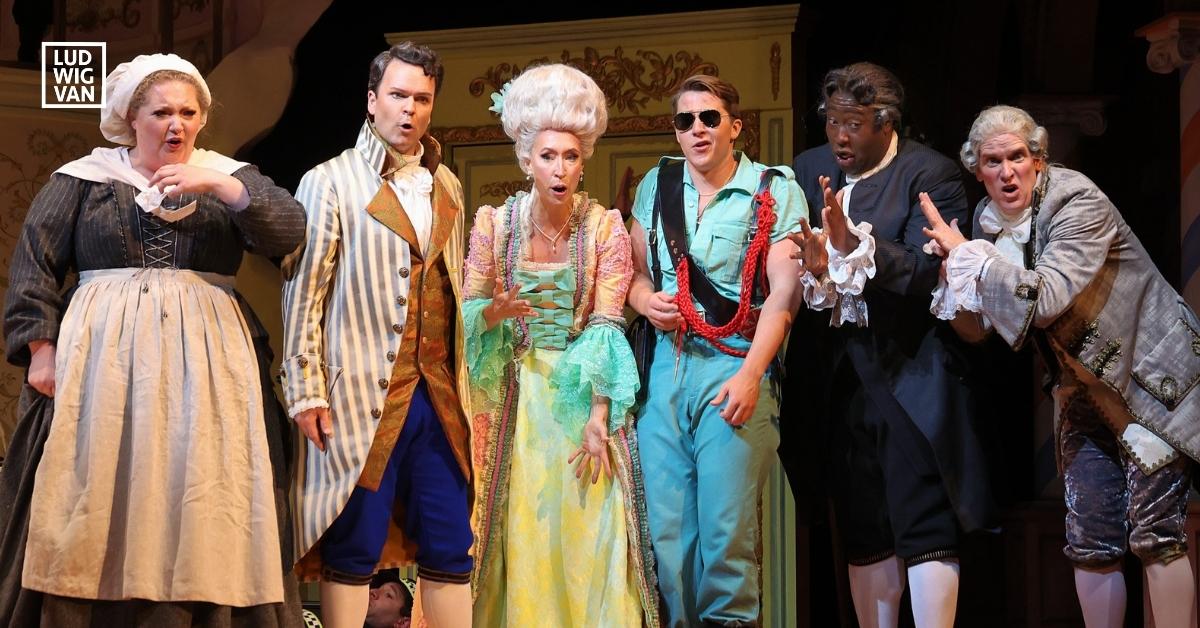
It hasn’t been easy the last two years for the Santa Fe Opera, now in its 65th season and arguably the most renowned summer opera festival in North America. Due to COVID-19, it suffered two seasons of cancellations and restricted offerings. With the pandemic now under better control, the Santa Fe Opera returns this summer (July 1 – August 27) with a full program of five productions. The offerings are Barber of Seville, Carmen, Falstaff, Tristan und Isolde, plus a world premiere, M. Butterfly. This season’s program is typical of Santa Fe Opera’s longstanding practice of presenting a mix of the old and the new, in an array of languages, featuring established stars as well as up-and-coming talents in principal roles, with supporting roles and chorus mostly taken by singers in its Apprentice Program.
I attended the Festival during Press Week (August 1-6), the first week of the summer season when it’s possible to see all five operas on consecutive nights. My opera feast kicked off with the Rossini’s Il barbiere, postponed from 2020 due to the pandemic. You can get a taste of Canadian baritone Joshua Hopkins singing his big aria taped in an empty Santa Fe house back in summer 2020. Then as now, Hopkins is an outstanding Figaro, one of his signature roles. On August 1, he sang “Largo al factotum” with beautiful, warm tone coupled with plenty of swagger. Emily Fons was a lively Rosina, with excellent coloratura. Kudos to tenor Jack Swanson, a boy-next-door yet mischievous Almaviva, his sweet tone and secure top a complete pleasure. As Bartolo, veteran bass Kevin Burdette, a frequent SFO guest artist, offered assured vocalism and a barrel of laughs with his physical comedy.
The striking production by Stephen Barlow with sets and costumes by Andrew Richards featured a huge bust with an orange shrub trimmed in the shape of a moustache. Stage direction emphasized physical comedy, and the talented cast was able to execute their comedic antics flawlessly, bringing gales of laughter from a very receptive audience. Musically it was also a fine evening, with the debuting Mexican maestro Ivan Lopez-Reynoso leading the orchestra in an effervescent reading of the delightful score.
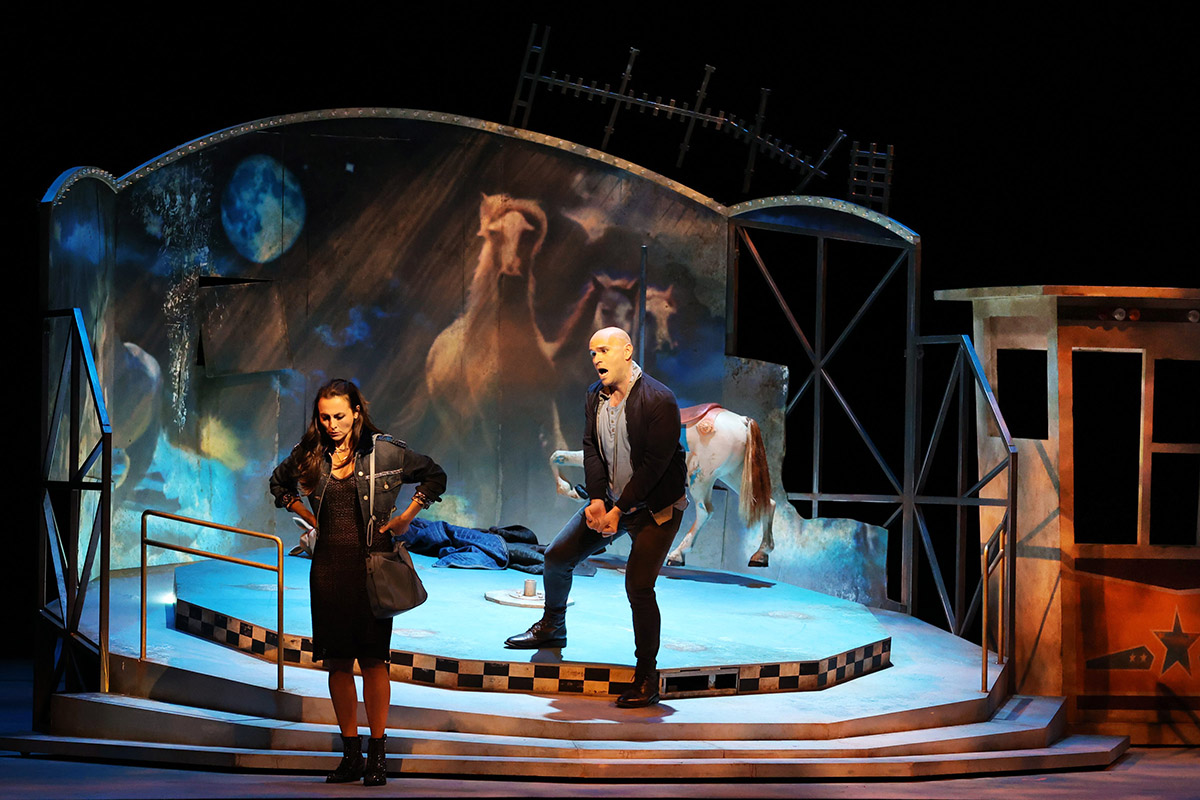
The Carmen production by French director Mariame Clement, while also set in Seville like Barbiere, that’s where the similarity ends, This is no typical Carmen — no bull ring but an amusement park, little if any Spanish flavour, with everyone in modern dress, a Carmen (Isabel Leonard) in blue jeans. It was an aesthetically dark and gritty take on the Carmen story. Seen on August 2, mezzo Isabel Leonard offered lovely vocalism, but her Carmen was curiously understated, even a touch cold. Likely a function of the director’s vision, Leonard’s Carmen, despite the mezzo’s personal beauty, was singularly lacking in sensuality and stage allure. Michael Fabiano (Don Jose) sang with burnished tone, throwing himself into the final confrontation, his violent attack on Carmen frighteningly realistic.
An unusual twist in the staging was the addition of a non-singing character, in the form of a young girl in a pretty pink dress, presumably a very young Carmen. It was a rather gimmicky touch that didn’t really add to the storytelling. Conductor Harry Bicket, the music director of Santa Fe Opera, led with a sure hand, eliciting lovely sounds from the pit. Overall, this Carmen was musically enjoyable, but production-wise a bit of a letdown after the high-energy Barber the previous evening.
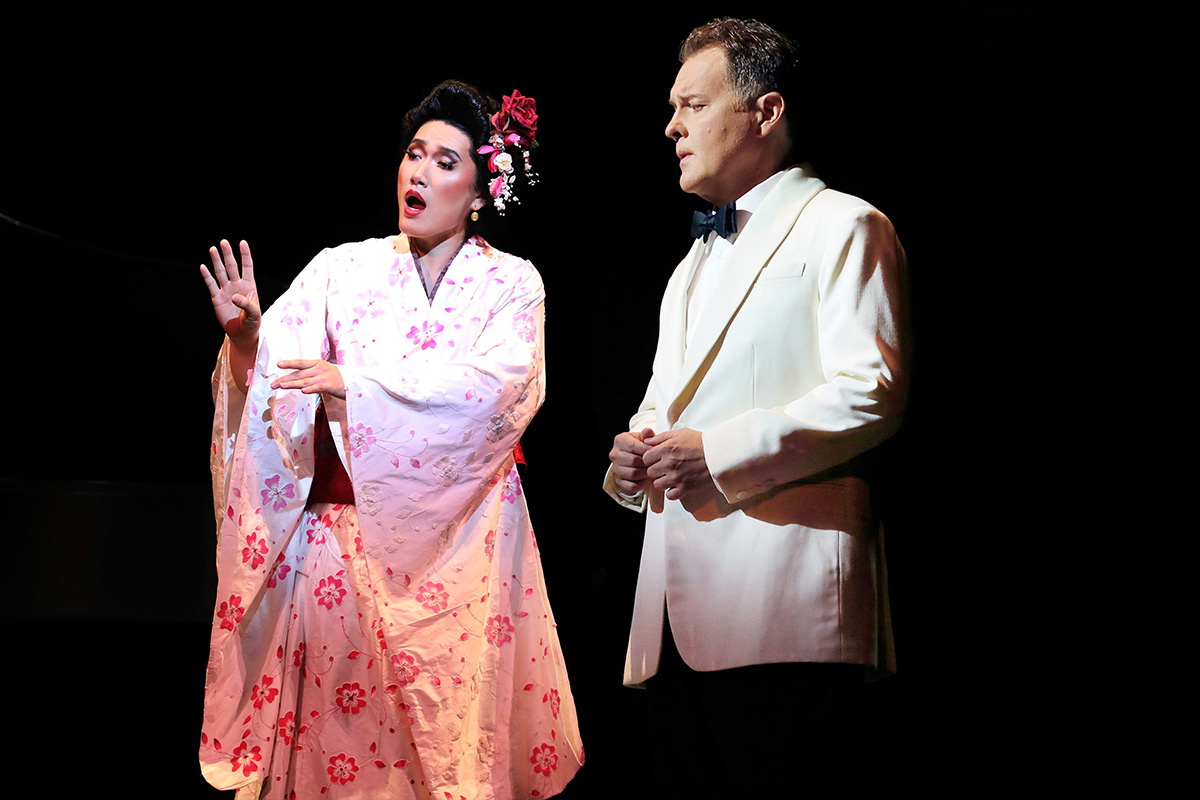
The premiering M. Butterfly was arguably the most anticipated show of this year’s Festival. This was another 2020 show postponed due to the pandemic, an operatic version of the original 1988 Broadway hit penned by David Henry Hwang. He reworked the text for the libretto of the opera, set to music by Chinese American composer Huang Ruo, whose earlier piece Dr. Sun Yat-sen had its North American premiere at the Santa Fe Opera in 2014. The director of M Butterfly is James Robinson and the set/costume designer is Allan Moyer, the same creative team as in the earlier opera.
The rather fantastical — though true story, only with names changed — of a French diplomat falling in love with a Chinese opera singer, who turned out to be not only a spy but a man, certainly had all the improbably dramatic ingredients for a sensational opera plot. Seen on Augusts 3, it was an impressive and entertaining piece of theatre, not easily forgotten. Countertenor Kangmin Justin Kim, of Kimchilia Bartoli fame, was an amazing Song Liling vocally and dramatically. Act one contains extensive and direct quotations of Puccini’s “Un bel di,” sung with aplomb by Kim, almost the complete aria but ending a few measures before the climactic high B-flat — an impressive start. It was also brave of him to do a scene with frontal nudity in Act 3, albeit modestly angled.
Kudos to British baritone Mark Stone as an excellent Gallimard. A very long and strenuous role which he sang unflaggingly and well. Musically the work is a melding of east and west, such as the use of percussion, and the peculiar vocal scooping at the end of a sung phrase, typical of Peking opera. To my ears, the music in Act One is generally less interesting, but the score builds and becomes more powerful and effective in Acts 2 and 3. A strong supporting cast, particularly noteworthy, was Chinese mezzo Hongni Wu as Comrade Chin, and the ubiquitous bass Kevin Burdette, as the French ambassador Manuel Toulon.
Given the improbability of the story, one that really stretches the imagination, the production was suitably fanciful and generally held my interest throughout. That said, Act One had its longueurs and would have benefited from some judicious trimming. I loved the multimedia projections, the excellent dance sequences, and the chorus of society partygoers that serves to advance the plot. If I were to quibble, the libretto could have benefited from a stronger sense of poetic imagination, given the nature of the story. A case in point is the much too factual dialogue between the lovers in the Act Three prison confrontation scene. That said, it was a notable success, and I look forward to its future revivals.
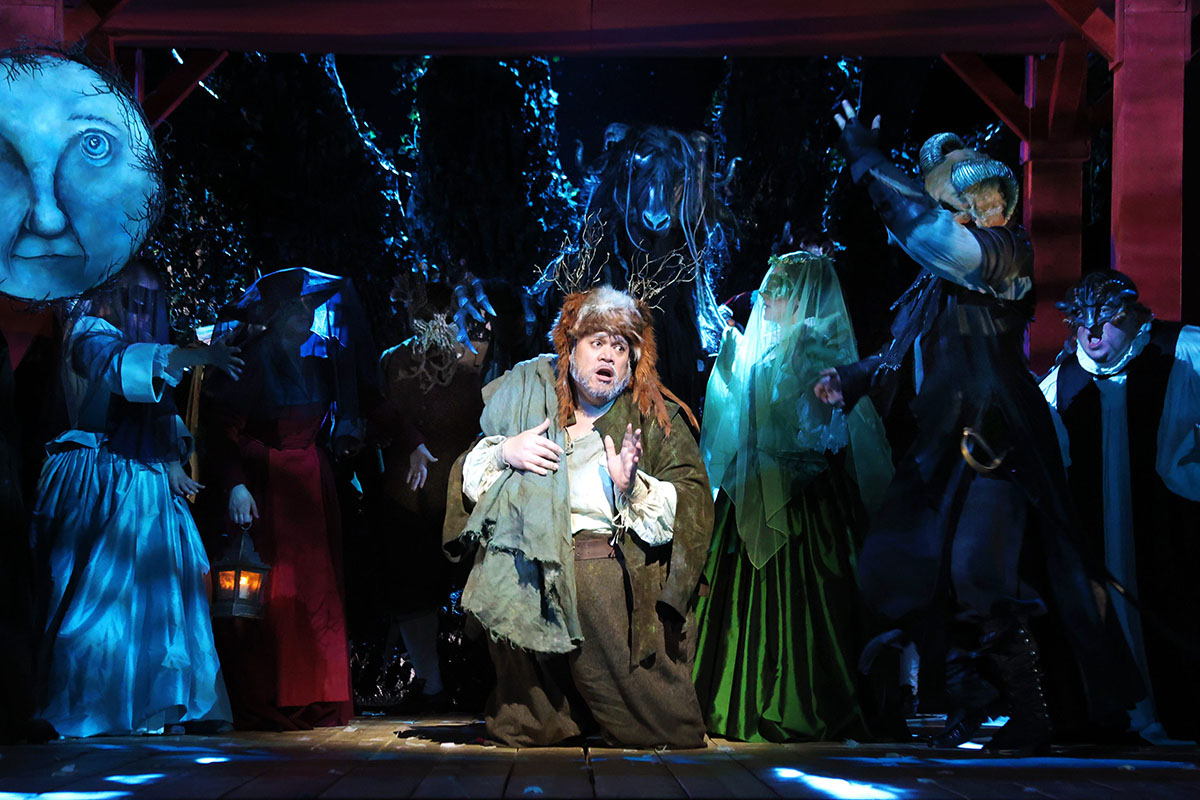
Unlike the new-fangled M. Butterfly, the David McVicar production of Falstaff was much more tradition-bound, with everything tried and true. The two-level set, all wood, could have come straight out of London’s Globe Theatre. The costumes were lovely, the stage direction was generally middle-of-the-road. Falstaff is an ensemble opera, and SFO has assembled a great cast, led by baritone Quinn Kelsey was a terrific Sir John. He sang the role beautifully while serving up plenty of belly laughs. I did notice a curiosity – Kelsey’s girth was noticeably reduced in the last scene, where the staging required him to roll around on the stage. Were the extra padding removed to allow greater mobility for him? In any case, Kelsey shared top vocal honours with British baritone Roland Wood, who was a brilliantly sung Ford, with huge volume, arguably the loudest singer onstage, and I mean that in a good way!
The women were equally strong. The standout was soprano Elena Villalón, a 2019 Met Auditions winner. Her Nannetta combined an engaging stage persona with a shimmering light lyric soprano capable of an exquisite high piano, a requisite for this role. Alexandra LoBianco was a formidable Alice Ford, making a big sound, solid high C’s aplenty to go with the grand gestures. The only thing wanting was a bit more legato and agility in the fast music. Anne McMahon Quintero was a creditable Dame Quickly, the only thing missing was a true contralto low register. British conductor Paul Daniel led the SFO forces in a lively and well-paced reading of the score, a bit of messiness between the singers and the orchestra in the ensemble passages notwithstanding. All in all, a traditional production to warm the heart.
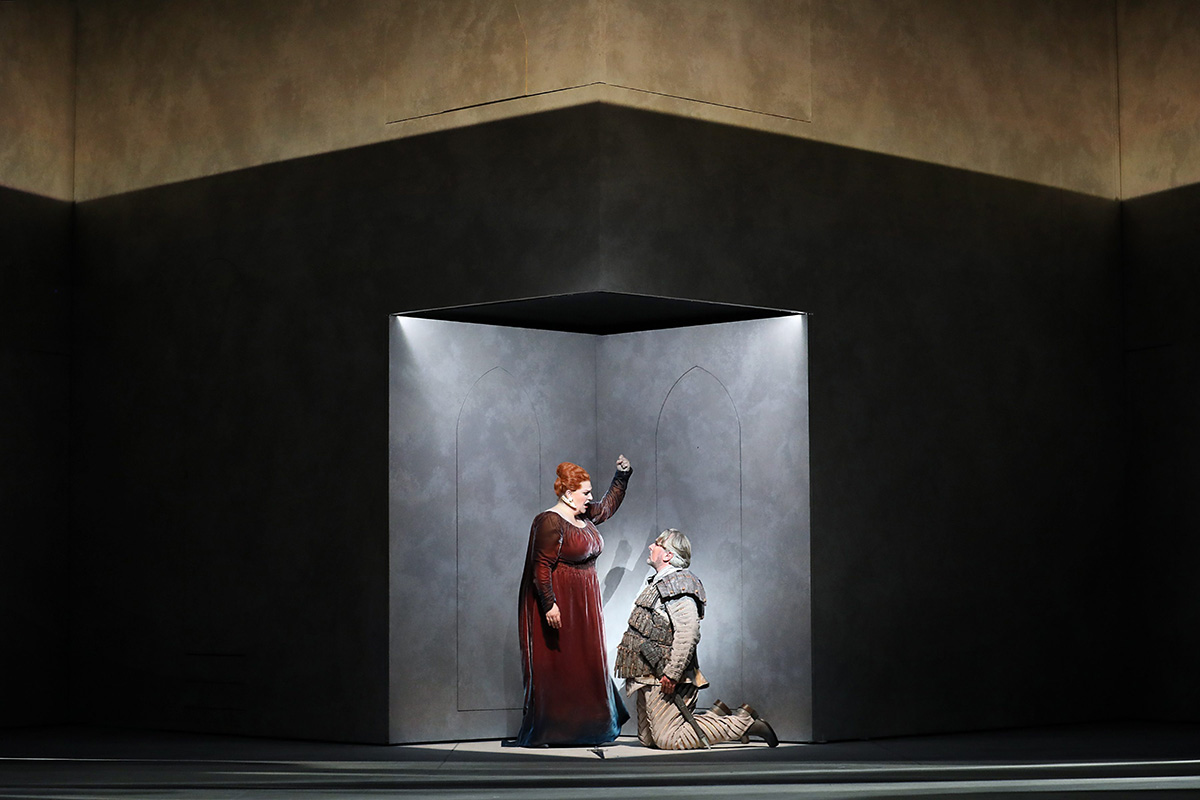
My Santa Fe sojourn concluded with Tristan und Isolde, the first Wagner at Santa Fe Opera in some thirty years. I’ve often wondered why the SFO founder/conductor John Crosby, a huge Richard Strauss fan, avoided programming Wagner. Given it’s an outdoor theatre with open sides, the long days don’t permit an early enough start for the Wagnerian marathons the likes of Götterdämmerung or Die Meistersinger. With an 8 pm start, the August 5 Tristan ended at 12:33 past midnight, which in some opera houses would mean overtime pay. In any case, it was a real privilege hearing the divine Tristan und Isolde surrounded by the magnificent New Mexican vista.
The SFO assembled a stellar cast led by tenor Simon O’Neill and soprano Tamara Wilson as the star-crossed lovers, plus Jamie Barton (Brangaene), Eric Owens (King Marke), and Nicholas Brownlee (Kurwenal). All except Brownlee have sung with distinction in Toronto, either at the COC or TSO. Here Wilson was a vocally superb Isolde, with fury in Isolde’s Curse, tenderness in the Love Duet, and a sense of transcendence in the Liebestod. As Tristan, O’Neill has stamina and sang with musicality, but his bright and somewhat tight tenor was not ideal, where a darker sound would have been more suited to this role. Barton was a very fine Brangäne, a great match for Isolde in Act One. With nearly identical hairdo and costume, the two could be sisters. Barton’s Act Two Brangäne’s Watch was a highlight. As Kurwenal, Nicholas Brownlee impressed with his clarion and robust baritone. I look forward to his Dutchman next summer.
The abstract production by Zack Winokur and Lisenka Heijboer Castañon was curiously understated. Perhaps one could make a case for not letting an in-your-face Regieoper approach, so commonplace in European houses, compete with the music, but this production is the other extreme. The basic design consists of three giant, movable panels with openings for entries and exits, enhanced with lighting effects. The theme of day versus night, so central to this opera, is well represented in this design, but naturalism is completely absent, not even hinted through video projections or lighting design. American conductor James Gaffigan, relatively new to the Wagnerian repertoire, led the orchestra with a sure hand, coaxing wonderful sounds from the pit. A most satisfying end to my Santa Fe Opera feast.
As I was leaving the opera house well after midnight, ushers were landing out brochures advertising the 2023 season, a mouth-watering lineup of Tosca, Rusalka, Pelleas et Melisande, Flying Dutchman, and Orfeo, featuring stars the likes of Rolando Villazon and Angel Blue. Be sure to mark your calendar!
- Met Live In HD 2022-23 Season Offers New And Familiar Works In Theatres & Online - October 24, 2022
- Santa Fe Opera Makes Welcome Return in 2022 Festival - August 23, 2022


